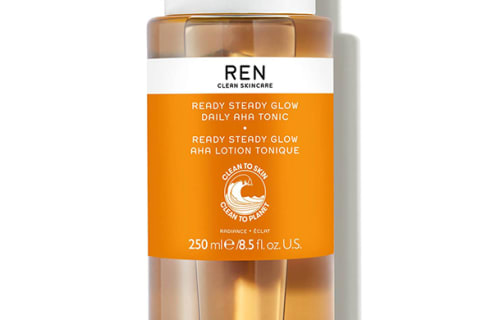Advertisement
Astringent vs. Toner: The Difference + Which You Should Use, From Experts


Toner is one contested topic. Some deem it an unnecessary skin care step; others swear by the extra pick-me-up for lifting residue post-wash. And of course, a high-quality toner does more than swipe away leftover dirt, oil, and grime: The toners of today are brimming with hydrating, brightening, and skin-regenerating actives. Is it a mandatory skin care step?
Not quite—certainly not as essential as cleansing or moisturizing. But can your skin benefit from the extra love? Perhaps!
If you do decide a toner is right for your routine, let us help you navigate the waters: On the hunt for your go-to formula, you may notice "astringents" popping up in the product category, and it's important you know the difference.
What is an astringent?
Essentially, astringents are extra-purifying toners. Their main gig is to remove oil from the skin, and they tend to be alcohol-based, which is why you might notice a temporary "tight" feeling after swiping one across your face. In addition to alcohol, astringents often feature witch hazel (which has naturally astringent properties), salicylic acid, citric acid, apple cider vinegar, and tea tree oil. It's these astringent ingredients that gave old-school toners their skin-tingling reputation.
As you can probably guess from the aforementioned ingredient list, astringents are best for oily and acne-prone skin types looking to further purify the skin post-cleanse. Although, the oil-stripping nature of astringents may be too much for some people to handle (namely dry and sensitive folks).
"The alcohol content can potentially be drying and irritating to the skin," says board-certified dermatologist Hadley King, M.D. Even those with oily complexions should be mindful of stripping the skin—after all, when the skin is zapped of moisture, it may respond with even more oil production to compensate.
What is a toner?
Toners cover a lot more ground: Some also purify and balance the skin after cleansing, featuring ingredients like AHAs, BHAs, and witch hazel, but toners tend to be water-based, which makes them far less drying. Not to mention, you can also find hydrating toners solely meant to infuse the skin with moisture and enhance product absorption later on in your routine; with these hydrating toners, you'll likely find hyaluronic acid, glycerin, aloe vera, and rosewater among the ingredient list.
"Toners are generally less harsh," says King. "They can be either hydrating or exfoliating, but even the ones with active exfoliating ingredients are still designed to contribute to the moisture barrier of the skin, not detract from it." That said, toners are pretty versatile across skin types: People with oily or acne-prone skin may choose a purifying number, while drier skin types may select a hydrating toner or essence to pump the skin with moisture.
(Read more about facial toners here.)
Summary
Which should you use?
Quick review: "Toners come in copious formulations and varieties that can be exfoliating, brightening, and/or hydrating and are available for every skin type," says dermatological nurse and celebrity esthetician Natalie Aguilar. "Astringents, on the other hand, are created for a very basic purpose, which is to reduce breakouts, minimize excessive oiliness, and deeply clean the skin."
Because toners are far more versatile across skin types (and they skip potentially irritating alcohols), we would consider ourselves Team Toner here at mbg—check out our favorite purifying and hydrating solutions here. However, if you have oily or acne-prone skin and fare well with a traditional astringent, we're not going to tell you to toss it. If it works for you, it works! Just keep an eye on your skin—if you notice any flaking or irritation after applying, you might want to find a different formula, ideally one without an alcohol base.
On that note, it's important not to get too caught up in the marketing language here. While astringents generally contain a higher alcohol content than toners, you may find an "astringent" product that uses, for example, just witch hazel for its oil-balancing properties. Similarly, you may come across an alcohol-based toner that can strip the skin—as always, check your ingredient lists and do a patch test before slathering on a new product.
How to use astringents & toners
You should apply both toners and astringents after your cleansing step. "They will help prep the skin for receiving subsequent products, such as essences, serums, oils, and moisturizers," notes Aguilar.
- After washing your face, apply the solution to a reusable cotton round and swipe it across your skin; you can also pour the solution into your palms and press it into your skin, or simply mist it over your face if your product comes in a spray format.
- Note: If you're using an astringent or a purifying toner, you'll want to apply it on a dry face to make sure those actives penetrate the skin cells. But if you're using a hydrating toner, applying on a damp face can actually help those humectants draw water into the skin.
- Follow with the rest of your skin care routine, making sure to seal everything in with a moisturizer.
Now, you may have heard of people using astringents and hydrating toners in the same routine to buffer the former product's drying effects. But this isn't really necessary: Rather than applying a hydrating mist to counter the stripping nature of an astringent, why not just use a gentler purifying toner in the first place? "I think it would make more sense to use a toner with both hydrating and astringent ingredients," says King.
Aguilar does say you can use both products together if you have combination skin: She suggests applying the astringent on oily areas prone to breakouts, then using a hydrating toner to calm and brighten the remaining regions. But, again, you could always just use one toner that contains purifying and hydrating ingredients to tick both boxes.
The takeaway
Astringents are essentially very strong toners—think of the old-school toners that leave your skin tight and tingly. Because of their alcohol content, astringents tend to be much more drying than toners—the latter are often pumped with hydrating actives (yes, even exfoliating formulas). Ultimately, we recommend you choose a water-based toner, no matter your skin goals; we've even dropped a few of our favorites below for purifying, balancing, and hydrating the skin.
-v1646695196476.jpg?1148x800)





















